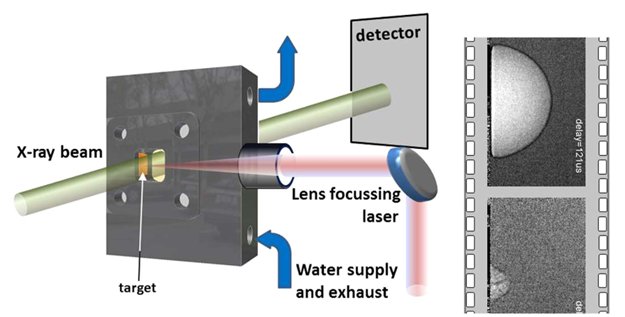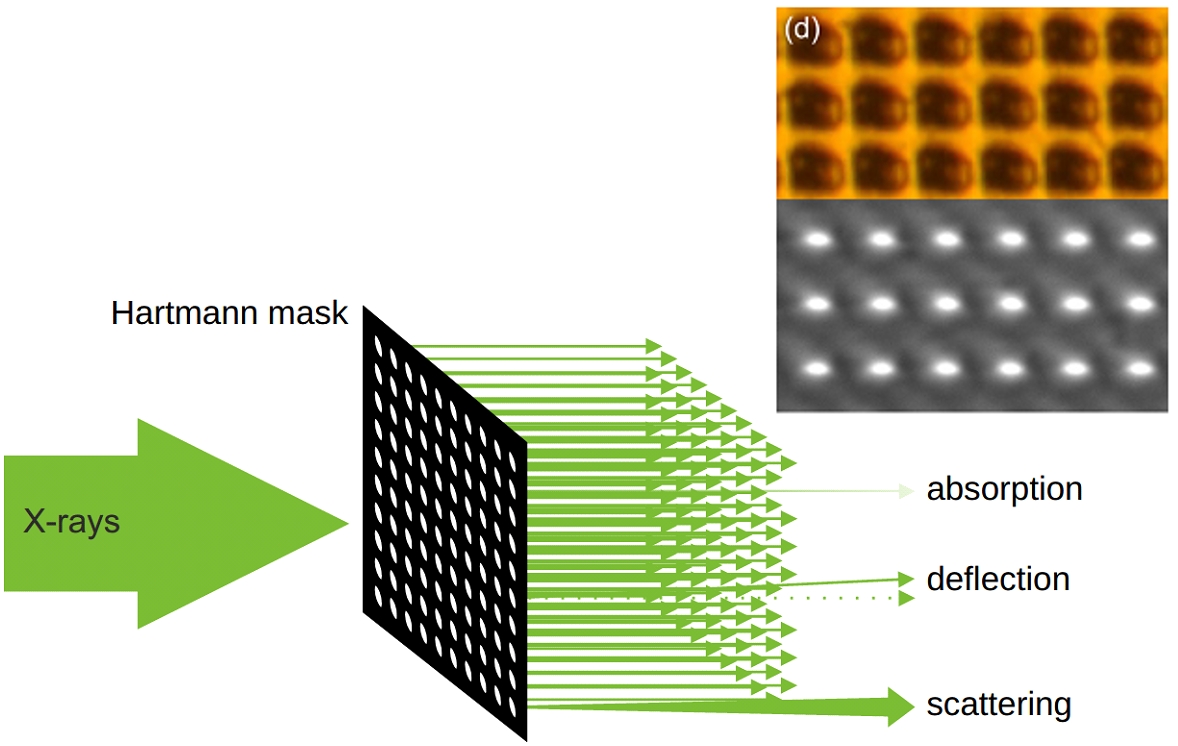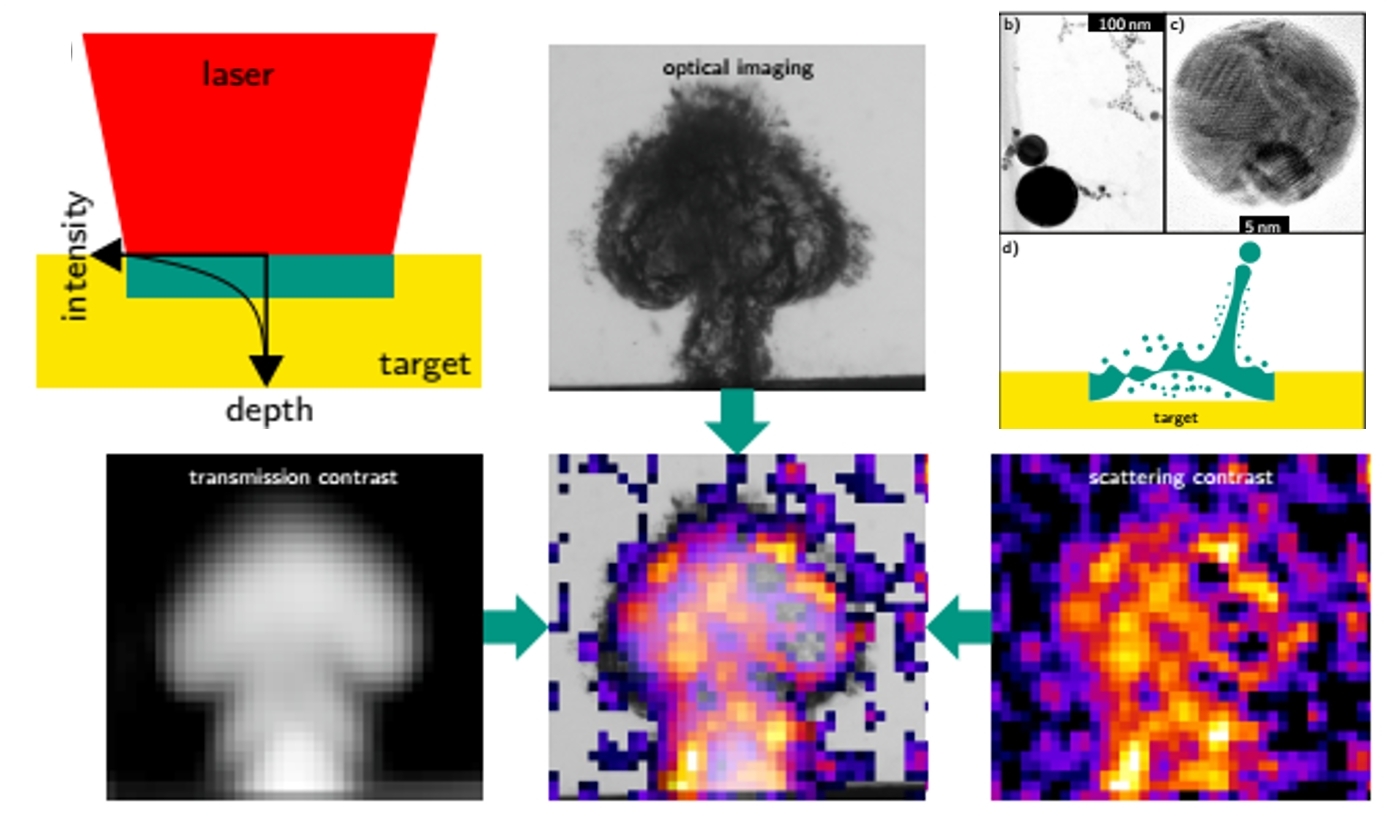Multicontrast imaging of laser ablation in liquids
Pulsed laser ablation in liquids (PLAL) is an easily accessible process to produce a wide range of nanomaterials in liquids without contamination from chemical processes. The goal of the project is to resolve the dynamics of PLAL by hierarchical in situ methods and to correlate nanoparticle genesis with macroscopic phenomenology.
The goal of the project has been to resolve the dynamics of pulsed laser ablation in liquids by hierarchical in situ methods and to correlate the nanoparticle genesis during this process with macroscopic phenomenology. This requires the development and application of methods, which are sensitive over a length-scale from millimetres down to nanometers, with a concurrently high time resolution on the microsecond scale. This has been achieved by correlating spatiotemporally resolved small-angle X-ray scattering (SAXS), UV-visual spectroscopic methods, visible-light stroboscopy (VISIMG) with fast X-ray imaging (XI) using contrast variation (XHI).
|
In the initial part of this project, we have developed contrast variation (based on Hartmann imaging) in order to be sensitive to the macroscale (absorption XR and phase-contrast XPC) and nanoscale (dark-field contrast). During this time, the correlation of bubble dynamics and particle formation in terms of particle size distribution and yield has been explored.
|
|
Several milestone results have been achieved that drew considerable attention in the scientific community:
- Particle size distribution, in particular, the usually observed bi- or multimodal distribution have inherent origins in the early stages of the ablation process itself: large (liquid) particles may be ejected in short-pulse (picosecond) PLAL through the mechanism of liquid film detachment and jet formation, while a second-stage agglomeration of particles trapped inside the bubble will cause size coarsening.
- Quenching of particle sizes therefore can already be active in the bubble, if electrolytes are added and prevent agglomeration during bubble collapse. The coupling of energy into the system and thus process efficiency can be monitored by the bubble sizes, both in terms of laser fluence and coupling-related incubation.
- Oxidation, in particular in the zinc system is characterized by the initial production of metallic zinc particles, which undergo gradual oxidation in water to form ZnO. Time-resolved X-ray absorption spectroscopy was for the first time employed for the study.
- In long-pulse (nanosecond) ablation a large fraction of the ablated species inside the bubble consists of isolated, active zinc species, which grow into particles within the duration of the first bubble.

|
|
|
Schematic setup for probing the structure evolution during pulsed laser ablation of a metal target (yellow block in right image) under water. Due to the extreme conditions a cavitation bubble develops, which initially contains most of the ablated material. |
Schematic of energy deposition and resulting cavitation observed via both visible light stroboscopy (upper image), X-ray radiography and scattering imaging, and correlated contrast image (lower middle image). |
Methodological development aiding the resolution of dynamics and detection of nanoparticle formation includes a thorough discussion of size definition through alternative (ex-situ) methods, development of time-resolved X-ray small-angle scattering (SAXS), X-ray imaging (XI), and X-ray spectroscopy (XAS). In particular, XI and SAXS could be merged into a contrast variable imaging technique using a Shack-Hartmann setup with arrays of X-ray microbeams. This technique has stimulated further developments at KIT.
The Shack- and Shack-Hartman masks were developed in collaboration with IMT at KIT.
The project is funded by the DFG under the contract no.: 262558940
Project partners
- IPS, KIT
- University Duisburg-Essen
- Institute of Microstructure Technology, KIT
Publications
- A hierarchical view on material formation during pulsed-laser synthesis of nanoparticles in liquid, Sci. Rep., 5 (2015) 16313, S. Ibrahimkutty, P. Wagener, T. dos Santos Rolo, D. Karpov, A. Menzel, T. Baumbach, S. Barcikowski, A. Plech, (https://doi.org/10.1038/srep16313)
- Pulsed laser ablation in liquids: Interaction of the bubble with particle formation, J. Coll. Interf. Sci., 489 (2017) 106-113, S. Reich, P. Schönfeld, P. Wagener, A. Letzel, B. Gökce, A. Menzel, T. dos Santos Rolo, S. Barcikowski. A. Plech, (https://doi.org/10.1016/j.jcis.2016.08.030)
- Size quenching during laser synthesis of colloids happens already in the vapor phase of the cavitation bubble, J. Phys. Chem. C, 121 (2017) 5356-5365, A. Letzel, B. Gökce, P. Wagener, S. Ibrahimkutty, A. Menzel, A. Plech, S. Barcikowski, (https://doi.org/10.1021/acs.jpcc.6b12554)
- A Shack-Hartmann sensor for single-shot multi-contrast direct- and reciprocal space in-situ imaging with hard X-rays, Appl. Sci. (Basel) 8 (2018) 737, T. dos Santos Rolo, S. Reich, D. Karpov, S. Gasilov, T. Baumbach, D. Kunka, A. Plech, (https://doi.org/10.3390/app8050737)
- Primary particle diameter differentiation and bimodality identification by five analytical methods using gold nanoparticle size distributions synthesized by pulsed laser ablation in liquids, Appl. Surf. Sci. 435 (2018) 743, A. Letzel, B. Gökce, A. Menzel, A. Plech and S. Barcikowski, (https://doi.org/10.1016/j.apsusc.2017.11.130)
- Scalable, large area compound array refractive lens for hard X-rays, Appl. Phys. Lett. 112 (2018) 151903, S. Reich, T. dos Santos Rolo, A. Letzel, T. Baumbach, A. Plech, (https://doi.org/10.1063/1.5022748)
- Early appearance of crystalline nanoparticles in pulsed laser ablation in liquids dynamics, Nanoscale 11 (2019) 6962 – 6969, S. Reich, A. Letzel, A. Menzel, N. Kretzschmar, B. Gökce, S. Barcikowski, A. Plech, (https://doi.org/10.1039/C9NR01203F)
- Materials synthesis in a bubble, MRS Bulletin 44 (2019) 382-391, Barcikowski, A. Plech, K. S. Suslick, A. Vogel, (https://doi.org/10.1557/mrs.2019.107)
- Time and Mechanism of Nanoparticle Functionalization by Macromolecular Ligands during Pulsed Laser Ablation in Liquids, Langmuir 35 (2019) 3038-3047, A. Letzel, S. Reich, T. dos Santos Rolo, A. Kanitz, J. Hoppius, A. Rack, M. Olbinado, A. Ostendorf, B. Gökce, A. Plech, S. Barcikowski, (https://doi.org/10.1021/acs.langmuir.8b01585)
- In situ speciation and spatial mapping of Zn products during pulsed laser ablation in liquids (PLAL), Nanoscale 12 (2020) 14011-14020, S. Reich, J. Göttlicher, A. Ziefuss, R. Streubel, G. Smolentsev, A. Letzel, S. Barcikowski, A. Menzel, O. Mathon, S. Pascarelli, T. Baumbach, M. Zuber, A. Plech, (https://doi.org/10.1039/D0NR01500H)


